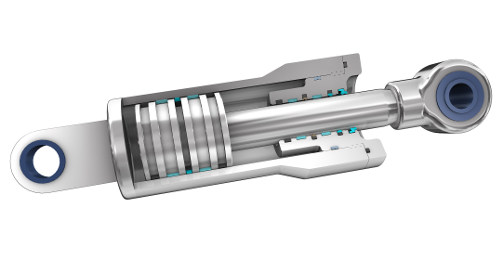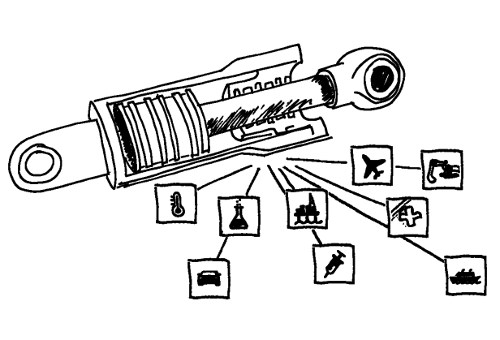 |
| September 09, 2014 | Volume 10 Issue 34 |
Designfax weekly eMagazine
Archives
Partners
Manufacturing Center
Product Spotlight
Modern Applications News
Metalworking Ideas For
Today's Job Shops
Tooling and Production
Strategies for large
metalworking plants
Hydraulics:
The 'dinosaur' returns, again and again
By Professor Josef Kurfess,
Head of the Department of Production Technology and Production Management,
Ulm University of Applied Sciences, Germany

Professor Josef Kurfess.
Over the past 40 years, hydraulic systems have been continually deemed a dying technology -- if not pronounced dead altogether. And these views don't seem all that farfetched in light of the on-going energy-efficiency debate and the apparent cure-all: electric drive systems. Perhaps the "dinosaurs of drive technology" are truly at an end. Yet they keep coming back and are more sustainable than ever -- all thanks to consistent, systematic thinking.
Hydraulics form the core technology behind many industrial companies and many of the applications we see in our daily lives. Whether it's at home or at work, whether it's in mobile or stationary applications, life as we know it wouldn't be possible without hydraulic systems. Sluices wouldn't open or close properly, construction vehicles wouldn't function correctly, cable cars wouldn't run, and most machines would no longer manufacture things. In the same vein, no theater stage would rotate, no harvesting machine would work quickly and precisely, and trucks couldn't unload their goods. Personal and professional life would become a lot less convenient.
Many developments spell optimization
That said, there have been many attempts over the past 40 years to replace hydraulic systems with other technologies. That's because, apart from their undisputed advantages, hydraulic systems and applications were considered coarse, clumsy, and only really of any use in rough industrial settings. They were also deemed inefficient energy hogs prone to leakages. In recent years, the energy debate has ferociously challenged hydraulic systems, and more and more electric solutions have tried to take on the leading role. Some have even predicted that hydraulic systems would share the same fate as the dinosaurs.
But the dinosaurs are coming back. A multitude of innovations, developments, and enhancements are seeing hydraulic systems and applications improve considerably -- and sustainably. There's no end in sight. Is there evidence of this? Our university of applied sciences has established an endowed chair for oil hydraulics, and our competence center for hydraulics now has 17 member companies -- clear indications of a renaissance. That's because one thing is certain: hydraulic systems are strong, robust, and they work more reliably than most comparable technologies. And little by little, they are regaining ground lost in the battle. The reasons for this are quite clear.
Hydraulic systems and applications are becoming more intelligent
Thanks to new ways of thinking and development approaches that focus on systems, hydraulic technology is becoming more efficient, versatile, and precise. By integrating high-performance electronics and control software, hydraulic systems are constantly becoming more "intelligent." All the while, the software also ensures that increasingly complex systems are becoming easier to operate. And that's not all -- the focus on systemic factors is reaching out into more and more areas.


The limits to how far we can stretch the mechanical production of control blocks are being eradicated, but when we do reach the limit, software can help us go further -- for example, when balancing oscillations at specific operating points. Control valves are becoming even more precise and faster. Oils and fluids are also advancing further. It's quite conceivable to develop fluid sensors that detect wear and report when a part should be exchanged.
Seals are becoming more application specific and are being developed in line with their intended use. They will reconcile the two opposing objectives of minimizing friction while maximizing sealing performance. This is giving rise to trendsetting sealing systems that can be connected or switched off, such as the Turcon Roto L system developed by Trelleborg Sealing Solutions. Such developments are paving the way for systems that we are already seeing in use, like a tire pressure system that allows for variable tire pressure and which can be adjusted while the system is running.
Hydraulics 4.0 -- autonomous systems are feasible
Hydraulic systems will gradually become even more intelligent. They will be self-monitoring by using high-performance sensors, and maintenance will not be carried out during downtime, but dynamically. Depending on the state and load of the hydraulic system, reports will be displayed indicating required maintenance or when to change components or fluids. All of this will be accompanied by the highest possible energy efficiency and even greater overall efficiency. And this isn't even taking Industry 4.0 into account. Quite conceivably, completely autonomous systems will exist in the future. These will monitor and service themselves -- more like Hydraulics 4.0. All of this bolsters the undisputed advantages of hydraulic drives: No other drive system is as powerful and as robust. The "dinosaurs of drive technology" might just outlive everything else.
Competence through cooperation
The Kompetenzzentrum Hydraulik is a privately funded center of excellence for hydraulics at Ulm University of Applied Sciences. It was established to promote the qualification of young talent as hydraulics specialists. The center, sponsored by the chamber of commerce and industry in Ulm (IHK Ulm), will receive over one million euros from its sponsoring companies, including Trelleborg Sealing Solutions, over the next five years. Each of these companies will also delegate a representative to sit on the advisory board to define core tuition and work activities.
Source: Trelleborg Sealing Solutions
Published September 2014
Rate this article
View our terms of use and privacy policy
